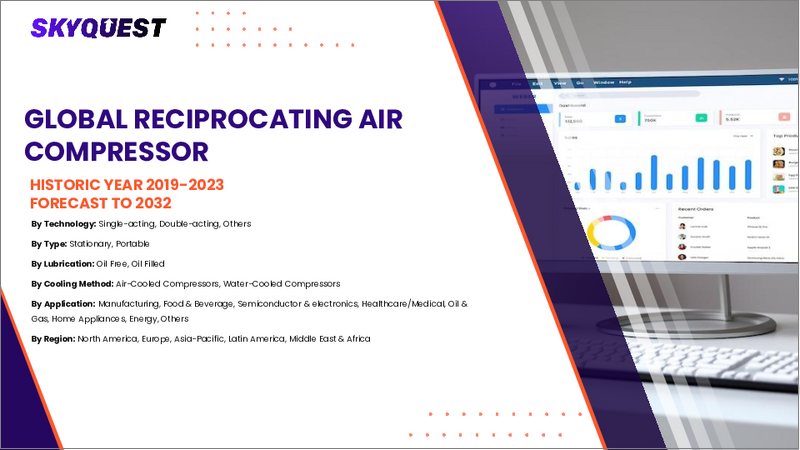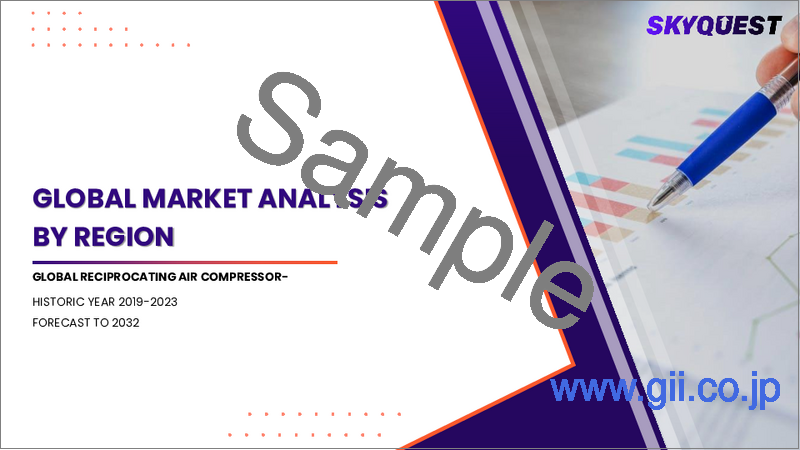|
|
市場調査レポート
商品コード
1681587
レシプロコンプレッサー市場規模、シェア、成長分析:コンプレッサータイプ別、動力源別、冷却方法別、用途別、エンドユーザー別、地域別 - 産業予測 2025~2032年Reciprocating Air Compressor Market Size, Share, and Growth Analysis, By Compressor Type, By Power Source, By Cooling Method, By Application, By End User, By Region - Industry Forecast 2025-2032 |
||||||
|
|||||||
| レシプロコンプレッサー市場規模、シェア、成長分析:コンプレッサータイプ別、動力源別、冷却方法別、用途別、エンドユーザー別、地域別 - 産業予測 2025~2032年 |
|
出版日: 2025年03月10日
発行: SkyQuest
ページ情報: 英文 202 Pages
納期: 3~5営業日
|
全表示
- 概要
- 目次
レシプロコンプレッサーの市場規模は2023年に59億米ドルで、2024年の62億1,000万米ドルから2032年には93億1,000万米ドルに成長し、予測期間(2025~2032年)のCAGRは5.2%で成長する見通しです。
レシプロコンプレッサー市場は、製油所、製薬、CNG/LNG貯蔵施設などさまざまな産業からの需要の高まりにより、複合年間成長率(CAGR)を示して力強い成長が見込まれています。これらの分野では、環境にやさしく効率的な可変速システムにシフトしており、特に高圧条件下でも作動可能な高性能オプションが好まれています。主要な市場関係者は、耐久性の向上、ガス流量の最適化、熱管理の改善に注力しており、潜在的な危険を防止するためには、圧力脈動と振動の厳密な監視が不可欠です。模倣品、激しい価格競争、容量密度の制限などの課題があるもの、予想される産業の成長と買い替えニーズにより、レシプロコンプレッサー市場は複数の分野で大幅な収益増加が見込まれています。
目次
イントロダクション
- 調査の目的
- 調査範囲
- 定義
調査手法
- 情報調達
- 二次と一次データの方法
- 市場規模予測
- 市場の前提条件と制限
エグゼクティブサマリー
- 世界市場の見通し
- 供給と需要の動向分析
- セグメント別機会分析
市場力学と見通し
- 市場概要
- 市場規模
- 市場力学
- 促進要因と機会
- 抑制要因と課題
- ポーターの分析
主な市場の考察
- 重要成功要因
- 競合の程度
- 主な投資機会
- 市場エコシステム
- 市場の魅力指数(2024年)
- PESTEL分析
- マクロ経済指標
- バリューチェーン分析
- 価格分析
- 規制情勢
- ケーススタディ
- 技術の進歩
レシプロコンプレッサー市場規模:コンプレッサータイプ別& CAGR(2025-2032)
- 市場概要
- 単段式コンプレッサー
- 2段式コンプレッサー
- 多段式コンプレッサー
レシプロコンプレッサー市場規模:動力源別& CAGR(2025-2032)
- 市場概要
- 電動式レシプロコンプレッサー
- ガス駆動式レシプロコンプレッサー
- 油圧式レシプロコンプレッサー
レシプロコンプレッサー市場規模:冷却方法別& CAGR(2025-2032)
- 市場概要
- 空冷式コンプレッサー
- 水冷式コンプレッサー
レシプロコンプレッサー市場規模:用途別& CAGR(2025-2032)
- 市場概要
- 産業
- 自動車
- 飲食品加工
- 医薬品
レシプロコンプレッサー市場規模:エンドユーザー別& CAGR(2025-2032)
- 市場概要
- 製造業
- 建設
- エネルギーと電力
- 輸送機関
レシプロコンプレッサー市場規模:地域別& CAGR(2025-2032)
- 北米
- 米国
- カナダ
- 欧州
- ドイツ
- スペイン
- フランス
- 英国
- イタリア
- その他欧州地域
- アジア太平洋地域
- 中国
- インド
- 日本
- 韓国
- その他アジア太平洋地域
- ラテンアメリカ
- ブラジル
- その他ラテンアメリカ地域
- 中東・アフリカ
- GCC諸国
- 南アフリカ
- その他中東・アフリカ
競合情報
- 上位5社の比較
- 主要企業の市場ポジショニング(2024年)
- 主な市場企業が採用した戦略
- 最近の市場動向
- 企業の市場シェア分析(2024年)
- 主要企業の企業プロファイル
- 企業の詳細
- 製品ポートフォリオ分析
- 企業のセグメント別シェア分析
- 収益の前年比比較(2022-2024)
主要企業プロファイル
- Burckhardt Compression(Switzerland)
- Bitzer SE(Germany)
- Kaeser Compressors(Germany)
- Fusheng(China)
- Bock GmbH(Germany)
- Atlas Copco(Sweden)
- Ingersoll Rand(USA)
- Gardner Denver(USA)
- Quincy Compressor(USA)
- ELGi Equipments(India)
- Doosan Portable Power(South Korea)
- MAT Industries LLC(USA)
- Saylor-Beall Manufacturing(USA)
- Champion Pneumatic(USA)
- Hubei Teweite Power Technology Co., Ltd.(China)
- VMAC Global Technology Inc.(Canada)
- BOGE Compressors(Germany)
- FS-Curtis(USA)
- Hitachi Industrial Equipment Systems Co., Ltd.(Japan)
結論と提言
Reciprocating Air Compressor Market size was valued at USD 5.9 billion in 2023 and is poised to grow from USD 6.21 billion in 2024 to USD 9.31 billion by 2032, growing at a CAGR of 5.2% during the forecast period (2025-2032).
The reciprocating compressor market is poised for robust growth, exhibiting a compound annual growth rate (CAGR) due to escalating demand from various industries such as refineries, pharmaceuticals, and CNG/LNG storage facilities. These sectors are shifting towards eco-friendly, efficient variable-speed systems, particularly favoring high-performance options capable of operating under high-pressure conditions. Key market players are focusing on enhancing durability, optimizing gas flow, and improving heat management, while rigorous monitoring of pressure pulsation and vibrations is critical for preventing potential hazards. Despite challenges such as counterfeit products, intense pricing competition, and limitations in capacity density, the anticipated industrial growth and replacement needs are expected to drive significant revenue increases in the reciprocating compressor market across multiple sectors.
Top-down and bottom-up approaches were used to estimate and validate the size of the Reciprocating Air Compressor market and to estimate the size of various other dependent submarkets. The research methodology used to estimate the market size includes the following details: The key players in the market were identified through secondary research, and their market shares in the respective regions were determined through primary and secondary research. This entire procedure includes the study of the annual and financial reports of the top market players and extensive interviews for key insights from industry leaders such as CEOs, VPs, directors, and marketing executives. All percentage shares split, and breakdowns were determined using secondary sources and verified through Primary sources. All possible parameters that affect the markets covered in this research study have been accounted for, viewed in extensive detail, verified through primary research, and analyzed to get the final quantitative and qualitative data.
Reciprocating Air Compressor Market Segments Analysis
Global Reciprocating Air Compressor Market is segmented by Compressor Type, Power Source, Cooling Method, Application, End User and region. Based on Compressor Type, the market is segmented into Single-Stage Compressors, Two-Stage Compressors and Multi-Stage Compressors. Based on Power Source, the market is segmented into Electric Reciprocating Compressors, Gas-Powered Reciprocating Compressors and Hydraulic Reciprocating Compressors. Based on Cooling Method, the market is segmented into Air-Cooled Compressors and Water-Cooled Compressors. Based on Application, the market is segmented into Industrial, Automotive, Food & Beverage Processing and Pharmaceuticals. Based on End User, the market is segmented into Manufacturing, Construction, Energy & Power and Transportation. Based on region, the market is segmented into North America, Europe, Asia Pacific, Latin America and Middle East & Africa.
Driver of the Reciprocating Air Compressor Market
The reciprocating air compressor market is driven by the inherent flexibility and versatility of these compressors, which allows them to cater to a diverse range of applications across multiple industries. Their ability to adapt to various operational needs makes them indispensable in sectors such as manufacturing, automotive, and healthcare, among others. This adaptability not only enhances their functionality but also increases their demand, as businesses seek efficient solutions for their specific requirements. Consequently, the growing recognition of reciprocating compressors' reliability and performance in meeting unique industry demands continues to fuel the expansion of this market segment.
Restraints in the Reciprocating Air Compressor Market
The reciprocating air compressor market faces significant challenges due to intense competition among manufacturers, which puts pressure on profit margins. This competitive landscape often leads to aggressive pricing strategies, particularly for standard reciprocating compressors, making it difficult for companies to maintain profitability. As different manufacturers vie for market share, the resulting price wars can diminish overall revenue potential, impacting the ability to invest in innovation and operational improvements. Consequently, these market dynamics could hinder the growth and sustainability of businesses operating within this sector, as they struggle to navigate the balance between competitive pricing and maintaining healthy profit margins.
Market Trends of the Reciprocating Air Compressor Market
The reciprocating air compressor market is experiencing a significant trend towards digitization and IoT integration, enhancing operational efficiency and productivity. Smart compressors equipped with digital monitoring capabilities facilitate remote monitoring and preventive maintenance, allowing users to make data-driven decisions to optimize performance. This shift not only reduces downtime through timely interventions but also promotes energy efficiency by enabling real-time analysis of operational parameters. As industries increasingly embrace automation and connectivity, the demand for advanced reciprocating air compressors with IoT features is poised to grow, driving innovation and shaping the future landscape of the market through enhanced industrial automation and smarter manufacturing solutions.
Table of Contents
Introduction
- Objectives of the Study
- Scope of the Report
- Definitions
Research Methodology
- Information Procurement
- Secondary & Primary Data Methods
- Market Size Estimation
- Market Assumptions & Limitations
Executive Summary
- Global Market Outlook
- Supply & Demand Trend Analysis
- Segmental Opportunity Analysis
Market Dynamics & Outlook
- Market Overview
- Market Size
- Market Dynamics
- Drivers & Opportunities
- Restraints & Challenges
- Porters Analysis
- Competitive rivalry
- Threat of substitute
- Bargaining power of buyers
- Threat of new entrants
- Bargaining power of suppliers
Key Market Insights
- Key Success Factors
- Degree of Competition
- Top Investment Pockets
- Market Ecosystem
- Market Attractiveness Index, 2024
- PESTEL Analysis
- Macro-Economic Indicators
- Value Chain Analysis
- Pricing Analysis
- Regulatory Landscape
- Case Studies
- Technological Advancement
Global Reciprocating Air Compressor Market Size by Compressor Type & CAGR (2025-2032)
- Market Overview
- Single-Stage Compressors
- Two-Stage Compressors
- Multi-Stage Compressors
Global Reciprocating Air Compressor Market Size by Power Source & CAGR (2025-2032)
- Market Overview
- Electric Reciprocating Compressors
- Gas-Powered Reciprocating Compressors
- Hydraulic Reciprocating Compressors
Global Reciprocating Air Compressor Market Size by Cooling Method & CAGR (2025-2032)
- Market Overview
- Air-Cooled Compressors
- Water-Cooled Compressors
Global Reciprocating Air Compressor Market Size by Application & CAGR (2025-2032)
- Market Overview
- Industrial
- Automotive
- Food & Beverage Processing
- Pharmaceuticals
Global Reciprocating Air Compressor Market Size by End User & CAGR (2025-2032)
- Market Overview
- Manufacturing
- Construction
- Energy & Power
- Transportation
Global Reciprocating Air Compressor Market Size & CAGR (2025-2032)
- North America (Compressor Type, Power Source, Cooling Method, Application, End User)
- US
- Canada
- Europe (Compressor Type, Power Source, Cooling Method, Application, End User)
- Germany
- Spain
- France
- UK
- Italy
- Rest of Europe
- Asia Pacific (Compressor Type, Power Source, Cooling Method, Application, End User)
- China
- India
- Japan
- South Korea
- Rest of Asia-Pacific
- Latin America (Compressor Type, Power Source, Cooling Method, Application, End User)
- Brazil
- Rest of Latin America
- Middle East & Africa (Compressor Type, Power Source, Cooling Method, Application, End User)
- GCC Countries
- South Africa
- Rest of Middle East & Africa
Competitive Intelligence
- Top 5 Player Comparison
- Market Positioning of Key Players, 2024
- Strategies Adopted by Key Market Players
- Recent Developments in the Market
- Company Market Share Analysis, 2024
- Company Profiles of All Key Players
- Company Details
- Product Portfolio Analysis
- Company's Segmental Share Analysis
- Revenue Y-O-Y Comparison (2022-2024)
Key Company Profiles
- Burckhardt Compression (Switzerland)
- Company Overview
- Business Segment Overview
- Financial Updates
- Key Developments
- Bitzer SE (Germany)
- Company Overview
- Business Segment Overview
- Financial Updates
- Key Developments
- Kaeser Compressors (Germany)
- Company Overview
- Business Segment Overview
- Financial Updates
- Key Developments
- Fusheng (China)
- Company Overview
- Business Segment Overview
- Financial Updates
- Key Developments
- Bock GmbH (Germany)
- Company Overview
- Business Segment Overview
- Financial Updates
- Key Developments
- Atlas Copco (Sweden)
- Company Overview
- Business Segment Overview
- Financial Updates
- Key Developments
- Ingersoll Rand (USA)
- Company Overview
- Business Segment Overview
- Financial Updates
- Key Developments
- Gardner Denver (USA)
- Company Overview
- Business Segment Overview
- Financial Updates
- Key Developments
- Quincy Compressor (USA)
- Company Overview
- Business Segment Overview
- Financial Updates
- Key Developments
- ELGi Equipments (India)
- Company Overview
- Business Segment Overview
- Financial Updates
- Key Developments
- Doosan Portable Power (South Korea)
- Company Overview
- Business Segment Overview
- Financial Updates
- Key Developments
- MAT Industries LLC (USA)
- Company Overview
- Business Segment Overview
- Financial Updates
- Key Developments
- Saylor-Beall Manufacturing (USA)
- Company Overview
- Business Segment Overview
- Financial Updates
- Key Developments
- Champion Pneumatic (USA)
- Company Overview
- Business Segment Overview
- Financial Updates
- Key Developments
- Hubei Teweite Power Technology Co., Ltd. (China)
- Company Overview
- Business Segment Overview
- Financial Updates
- Key Developments
- VMAC Global Technology Inc. (Canada)
- Company Overview
- Business Segment Overview
- Financial Updates
- Key Developments
- BOGE Compressors (Germany)
- Company Overview
- Business Segment Overview
- Financial Updates
- Key Developments
- FS-Curtis (USA)
- Company Overview
- Business Segment Overview
- Financial Updates
- Key Developments
- Hitachi Industrial Equipment Systems Co., Ltd. (Japan)
- Company Overview
- Business Segment Overview
- Financial Updates
- Key Developments





